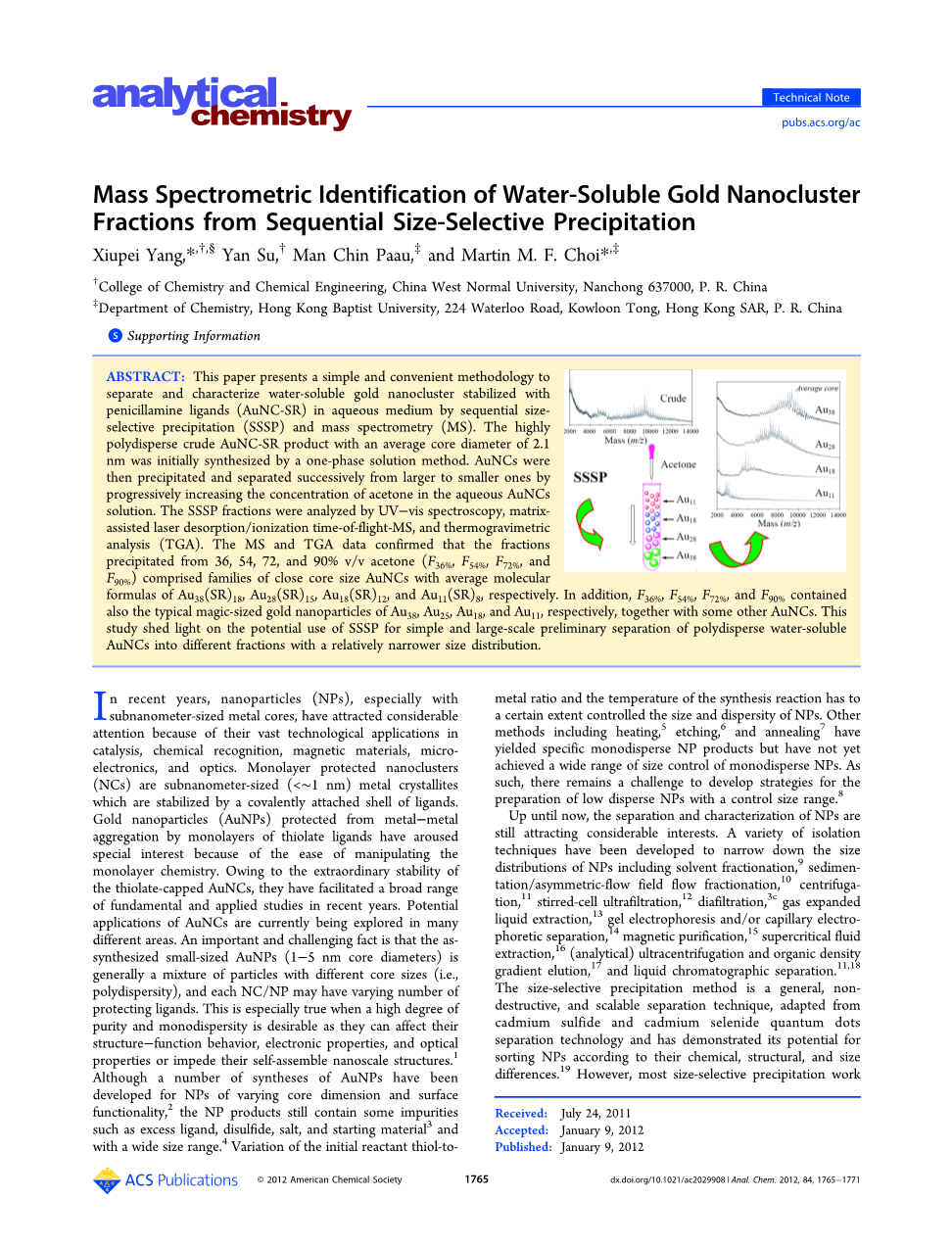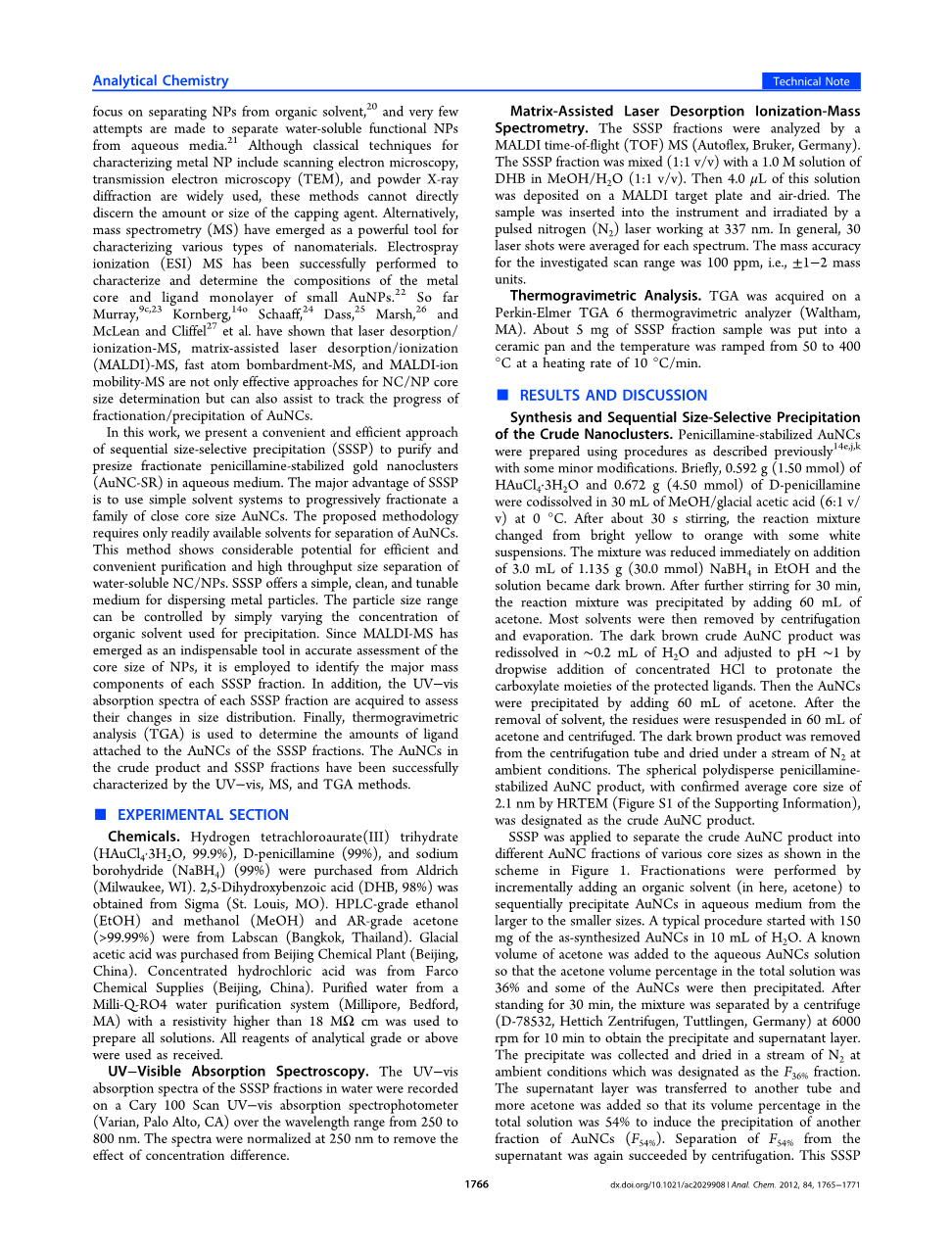

英语原文共 7 页,剩余内容已隐藏,支付完成后下载完整资料
Mass Spectrometric Identification of Water-Soluble Gold Nanocluster Fractions from Sequential Size-Selective Precipitation
质谱仪检测水溶性金纳米团簇的尺寸梯度沉淀比例
ABSTRACT: This paper presents a simple and convenient methodology to separate and characterize water-soluble gold nanocluster stabilized with penicillamine ligands (AuNC-SR) in aqueous medium by sequential sizeselective precipitation (SSSP) and mass spectrometry (MS). The highly polydisperse crude AuNC-SR product with an average core diameter of 2.1 nm was initially synthesized by a one-phase solution method. AuNCs were then precipitated and separated successively from larger to smaller ones by progressively increasing the concentration of acetone in the aqueous AuNCs solution. The SSSP fractions were analyzed by UVminus;vis spectroscopy, matrix assisted laser desorption/ionization time-of-flight-MS, and thermogravimetric analysis (TGA). The MS and TGA data confirmed that the fractions precipitated from 36, 54, 72, and 90% v/v acetone (F36%, F54%, F72%, and F90%) comprised families of close core size AuNCs with average molecular formulas of Au38(SR)18, Au28(SR)15, Au18(SR)12, and Au11(SR)8, respectively. In addition, F36%, F54%, F72%, and F90% contained also the typical magic-sized gold nanoparticles of Au38, Au25, Au18, and Au11, respectively, together with some other AuNCs. This study shed light on the potential use of SSSP for simple and large-scale preliminary separation of polydisperse water-soluble AuNCs into different fractions with a relatively narrower size distribution.
摘要:本文展示了一种简单而方便的用于一种青霉胺稳定化处理后的水溶性金纳米团簇的分离和标定的方案,利用尺寸梯度沉淀法(SSSP)和质谱法(MS)。我们使用单一相合成的粗制的内核直径2.1nm的高分散AuNC-SR产品。通过向金纳米团簇溶液中逐渐加大丙酮的浓度,成功将金纳米团簇按照粒径从大到小逐步沉淀出来。我们利用紫外-可见光分光光度仪,基质辅助激光解析电离一飞行时间质谱,以及热重分析来检测尺度梯度沉淀法(SSSP)的结果。质谱和热重分析的分析结果表明在丙酮体积浓度为36%,54%,72%和90%(F36%, F54%, F72%, 和 F90%)时,析出产物的平均分子结构分别为Au38(SR)18, Au28(SR)15, Au18(SR)12, 和Au11(SR)8。除此之外,F36%, F54%, F72%, and F90%的产物又包含了不可思议的Au38, Au25, Au18, 和Au11的尺寸的产物,以及其他的金纳米团簇。这个研究结果表明了尺寸梯度沉淀法(SSSP)在水溶性金团簇进行小尺寸区间分离时的应用潜力。
In recent years, nanoparticles (NPs), especially withsubnanometer-sized metal cores, have attracted considerableattention because of their vast technological applications incatalysis, chemical recognition, magnetic materials, microelectronics,and optics. Monolayer protected nanoclusters(NCs) are subnanometer-sized (lt;~1 nm) metal crystalliteswhich are stabilized by a covalently attached shell of ligands.Gold nanoparticles (AuNPs) protected frommetalminus;metalaggregation by monolayers of thiolate ligands have arousedspecial interest because of the ease of manipulating themonolayer chemistry. Owing to the extraordinary stability ofthe thiolate-capped AuNCs, they have facilitated a broad rangeof fundamental and applied studies in recent years. Potentialapplications of AuNCs are currently being explored in manydifferent areas. An important and challenging fact is that the assynthesizedsmall-sized AuNPs (1minus;5 nm core diameters) isgenerally a mixture of particles with different core sizes (i.e.,polydispersity), and each NC/NP may have varying number ofprotecting ligands. This is especially true when a high degree ofpurity and monodispersity is desirable as they can affect theirstructureminus;function behavior, electronic properties, and opticalproperties or impede their self-assemble nanoscale structures.1Although a number of syntheses of AuNPs have beendeveloped for NPs of varying core dimension and surfacefunctionality,the NP products still contain some impuritiessuch as excess ligand, disulfide, salt, and starting material andwith a wide size range.Variation of the initial reactant thiol-tometalratio and the temperature of the synthesis reaction has toa certain extent controlled the size and dispersity of NPs. Othermethods including heating, etching, and annealing haveyielded specific monodisperse NP products but have not yetachieved a wide range of size control of monodisperse NPs. Assuch, there remains a challenge to develop strategies for thepreparation of low disperse NPs with a control size range.
Up until now, the separation and characterization of NPs arestill attracting considerable interests. A variety of isolationtechniques have been developed to narrow down the sizedistributions of NPs including solvent fractionation, sedimentation/asymmetric-flo fiel flow fractionation,centrifugation,stirred-cell ultrafiltration, diafiltration,3c gas expandedliquid extraction,gel electrophoresis and/or capillary electrophoreticseparation,magnetic purification,supercritical fluidextraction, (analytical) ultracentrifugation and organic densitygradient elution, and liquid chromatographic separation.The size-selective precipitation method is a general, nondestructive,and scalable separation technique, adapted fromcadmium sulfide and cadmium selenide quantum dotsseparation technology and has demonstrated its potential forsorting NPs according to their chemical, structural, and sizedifferences.However, most size-selective precipitation work focus on separating NPs from organic solvent,20 and very fewattempts are made to separate water-soluble functional NPsfrom aqueous media.21 Although classical techniques forcharacterizing metal NP include scanning electron microscopy,transmission electron microscopy (TEM), and powder X-raydiffraction are widely used, these methods cannot directlydiscern the amount or size of the capping agent. Alternatively,mass spectrometry (MS) have emerged as a powerful tool forcharacterizing various types of nanomaterials. Electrosprayionization (ESI) MS has been successfully performed tocharacterize and determine the compositions of the metalcore and ligand monolayer of small AuNPs.22 So farMurray,9c,23 Kornberg,14o Schaaff,24 Dass,25 Marsh,26 andMcLean and Cliffel27 et al. have shown that laser desorption/ionization-MS, matrix-assisted laser desorp
全文共27893字,剩余内容已隐藏,支付完成后下载完整资料
资料编号:[8718],资料为PDF文档或Word文档,PDF文档可免费转换为Word
您可能感兴趣的文章
- 复杂热电材料外文翻译资料
- 以自蔓延高温烧结方法制备热电化合物以及燃烧合成的新标准外文翻译资料
- 氮掺杂分级多孔碳作为氧还原反应的高效电化学催化剂的研究外文翻译资料
- 孪晶诱导塑性高嫡合金的设计外文翻译资料
- 含铌先进Fe-Cr-Ni型奥氏体耐热钢富铜相的析出强化在超临界电厂的应用外文翻译资料
- 不同温度下直接能量沉积层状工具钢的弯曲强度外文翻译资料
- BiFeO3的光伏效应外文翻译资料
- 通过氢稳定的MgaPt研究核壳纳米结构Mg@Pt中快速“氢泵”的可视化外文翻译资料
- 一种铱核心环金属有机配体显著地提高了有机太阳能电池 的光伏性能外文翻译资料
- 钠离子电池的高性能阳极材料:三组分共组装法制备层次多孔碳外文翻译资料


